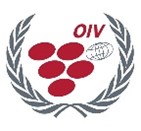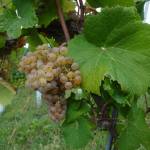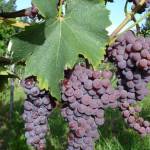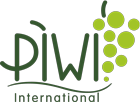Wolfgang Renner, Research Station Haidegg, Chairman PIWI Austria, Board Member PIWI International
With advancing climate change and the need to meet the challenges of the “Green Deal” in agriculture, too, interest in sustainable production methods is growing. Fungal-resistant grape varieties are a functioning alternative for viticulture.
In Austria, according to multiple applications, around 1.5 percent of the vineyard area is currently planted with fungus-resistant grape varieties. This corresponds to an absolute area of around 700 hectares. In Styria there are around 150 hectares (2.9% of the Styrian vineyards). Muscaris, souvignier gris and flower muscatel are most commonly grown here. But what happens outside of Austria in traditionally “conservative” wine-growing countries? -
Here is a brief overview of some of the activities in Europe and overseas.
FRANCE ![]()
"France's hybrid wine future! "
The French wine landscape is about to undergo a revolution due to the gentle push for resistant grape varieties by the Institut National de la Recherche Agronomique (INRA), known as INRA-ResDur. The aim of this program is to breed multi-resistant varieties for local cultivation with a strong local character by 2030. All of the main French cultivation areas are involved. It is probably the largest varietal improvement program in the world. In 2018, four fungus-resistant varieties were included in the national variety catalog: Artaban, Vidoc, Floreal and Voltis. In this report, José Vouillamoz, Swiss biologist and expert on genetic studies of grape varieties at the Agroscope, is quoted: "There is no scientific evidence that Pinot noir transports terroir better than Regent".
Source: www.wine-searcher.com, 5.1.2020
In June 2021, the online magazine Vitisphere (www.vitisphere.com) reported that the CPVO (Community Plant Variety Office, European Plant Variety Office) the four French PIWI varieties Artaban, Vidoc, Floreal and Voltis were classified as Vitis vinifera L. This clears the way for a possible classification as AOC wine in France.
Champagne growers help breed the grape varieties of the future
For ten years, Champagne has been participating in the INRA-ResDur program as an in-situ growing region, which is currently in an "intermediate stage". Seedlings with the necessary resistance genes were planted in the experimental vineyards in Champagne. There they are observed over a period of about six years. These will be narrowed down and further monitored before a final administrative round takes place, which will hopefully secure a catalog spot for four or five more varieties that will thrive in the “future climate”. The whole process takes about 15 years.
Source: www.forbes.com, 16.9.2020
Almost a year later, the Swedish magazine BKWine reported that the umbrella association of champagne winemakers had decided to approve a fungus-resistant grape variety (Voltis). The champagne producers are allowed to plant a maximum of 5% of their vineyards with this variety.
Source: www.bkwine.com, August 23, 2021
ICV examines 106 vinification of resistant grape varieties
The Institut Coopératif du Vin (ICV) is beginning to get a good overview of the oenological suitability of the resistant grape varieties. Since 2014, 106 wines from 20 varieties have been vinified, most of which are already available. Oenologists like the Souvignier gris because of its balanced acidity and finesse. Floréal is very aromatic. The red wines behave well in blends, but are often characterized by aggressive tannins when they are vinified on their own. The oenologists now also have an idea of the ripening times. Several varieties are quite late and well adapted to the Mediterranean. Artaban, Vidoc, Monarch, Prior or Voltis generally reach 13 % alcohol in mid-September after Cabernet Sauvignon. The resistant red varieties also cover a wide range of acidity levels. Some have higher total acidity and a lower pH than Syrah, Grenache, Merlot, Carignan, or Cabernet Sauvignon. This is the case with Merlot Khorus, for example, which could be a good solution to climate change. Artaban, Vidoc, Merlot Khorus and Monarch have an interesting color intensity, but also a very high tannin load.
Source: www.vitisphere.com, January 26, 2021
The Languedoc monitors 100 plots of resistant grape varieties
A new network of winemakers who have planted resistant grape varieties enables wine consultants to get a better picture of behavior in the various terroirs of the Mediterranean arc.
Source: www.vitisphere.com, January 26, 2021
Charentes wineries rely on resistant varieties
The movement picks up speed. The cellar of the Ile d'Oléron vinified its first cuvée of grape varieties that are resistant to Oidium and Peronospora. The Coopérative Vignerons de Ile de Ré will plant around ten varieties this year. As alternatives to the conventional Ugni blanc variety, some fungus-tolerant varieties are to be approved.
Source: www.vitisphere.com, October 28, 2020
Resistant grape varieties from the Rhone Valley in 2035?
While the successive INRA ResDur programs 1, 2 and 3 made it possible to offer grape varieties that are resistant to powdery mildew and oidium - especially with the first registrations of Vidoc, Artaban, Floréal and Voltis - the wine-growing regions and their industry associations are taking advantage of these new ones Materials in regional crossing programs. The grape varieties in their area should be given permanent resistance to downy mildew, oidium, black rot, etc. In the Rhône Valley, Syrah and Grenache were crossed last year.
Source: https://www.vaucluse-agricole.com, 10/28/2020
OIV resolutions

The International Wine Office (OIV) has drawn attention to the PIWI issue in the recent past with two resolutions. Resolution 609-2019 states that the OIV does not want any existing variety names for resistant hybrids. A resolution recommends avoiding any risk of confusion for consumers!
Resolution 652-2021 recommends a recommendation for the selection and breeding of grape varieties for their adaptation to the effects of climate change. It is particularly emphasized that increased international cooperation between scientific institutions must be promoted in order to facilitate research in the field of vine selection and breeding and to ensure a faster introduction of innovative varieties that are better adapted to climate change.
ITALY ![]()
In 2020, four varieties (F22P9, F22P10, F23P65, F26P92) of the Fondazione Edmund Mach (San Michele) were included in the national Italian variety list.
Source: Wine News, The Pocket Wine Web Site In Italy, June 30, 2020
7 resistant grapes were selected for the Trentino viticulture as part of the “Vevir project”
These are the varieties Nermantis, Termantis, Valnosia, Charvir, Solaris, Souvignier gris and Pinot Regina, which are resistant to oidium and downy mildew. The four-year Vevir project, in which tests were carried out in various wine-growing regions in Trentino, was coordinated by the Consorzio Innovazione Vite (Civit), the partner for scientific aspects was the Fondazione Edmund Mach (Edmund Mach Foundation). The tests were conducted for productivity, disease tolerance and oenological potential. The varieties were compared with the Chardonnay and Marzemino traditionally used in this area. Four of the seven grape varieties have emerged from the genetic improvement program of the Edmund Mach Foundation: Termantis (blue), Nermantis (blue), Charvir (white), Valnosia (white).
Source: https://civiltadelbere.com/, 31.3.2021
News for the winemakers with more resistant varieties: in Emilia-Romagna it will be possible to grow 9 new grape varieties
The nine wine grape varieties that the Research Center for Crop Production (Crpv) developed after several years of trials at the Tebano (Faenza) site have shown numerous positive properties. Following the field tests, the Crpv asked the administration of the Emilia-Romagna region to officially recognize the grape varieties. Despite a drastic reduction in treatments, they proved to be resistant or tolerant to the most important fungal diseases.
The following were included in the regional grape variety register of Emilia-Romagna: Merlot Kanthus, Merlot Khorus, Cabernet Volos, Cabernet Eidos (all blue), Sauvignon Kretos, Sauvignon Rytos, Johanniter, Souvignier gris and Solaris (all white). The grapes of these varieties may only be used for the production of table wine and / or IGT (geographical indication). They are still banned for the production of DOC wines.
Source: https://notizie.regione.emilia-romagna.it/, March 16, 2020
![]() United States New Grape Varieties, New Wine Program for Arkansas
United States New Grape Varieties, New Wine Program for Arkansas
After more than 20 years of research, two new grape varieties emerged from the grape breeding program at the University of Arkansas. Indulgence, a white grape variety with a nutmeg aroma, comes from a cross between Seyval and Muscat Ottonel. Dazzle, a red-skinned variety with a Gewürztraminer-like character, was crossed from Gewürztraminer x Melody (a New York hybrid). The aim of the breeding program was to develop new grape varieties that have the potential for high quality in the Middle South, a region with cold winters and hot and humid summers.
Source: www.winebusiness.com, 11/17/2020
High hopes for hybrid grapes
Winter hardy varieties from the University of Minnesota are opening up new opportunities
The University of Minnesota pioneered the breeding of grape varieties for cold climates, not just in the upper Midwest. The main property of the University of Minnesota grape varieties is winter hardiness, but the project also includes breeding for disease resistance (especially powdery mildew and downy mildew) and acidity reduction. In the “Excelsior” facility, there are more than 10,000 experimental vines on 12 hectares, which produce thousands of seedlings every year. The project's genetic base includes Vitis vinifera varieties and French hybrids, but the genetic backbone is Vitis riparia, Minnesota's native grape variety. Two resistant grape varieties have only been released in recent years: Itasca (white) and Marquette (blue). Itasca shows resistance to oidium, downy mildew and phylloxera. Marquette is characterized above all by great winter hardiness.
Source: https://www.goodfruit.com/high-hopes-for-hybrid-wine-grapes/, 11/12/2019
Germany![]()
The PIWI topic has been gaining momentum in Germany for a long time. The cultivation area is around 2.5%, which corresponds to around 2,500 hectares.
The Felicia grape variety, bred at the Julius Kühn Institute. It is resistant to powdery mildew, downy mildew and black rot. For the second time, the Falstaff PIWI Trophy was carried out by the wine publisher of the same name and the best German PIWI wines were selected. The PIWI Deutschland eV association is committed to sustainability in viticulture. From the vine to the wine in the glass, campaigns and projects are to be promoted in Germany that broaden the level of awareness of PIWIS and make it clear that quality and enjoyment can be reconciled with sustainability, ecology and biodiversity. www.piwi-deutschland.de
News from Austria![]()
In July, the PIWI wine competition “New / innovative grape varieties” for Austrian wines, organized by the PIWI Austria association, took place again. A total of 165 wines were registered by 83 companies from eight federal states. The white wines naturally dominated the entries, the strongest variety (30 registered wines) was Muscaris, followed by Souvignier gris (23) and Donauriesling (18). The Roesler grape variety (11) was most frequently submitted for red wines. An international jury of experts tasted and rated the wines in the sensory room of the Haidegg research institute in Graz. Ten category winners were chosen. More information on www.piwi-international.de/piwi-regional/oesterreich/.



Danube giant Souvignier Gris

